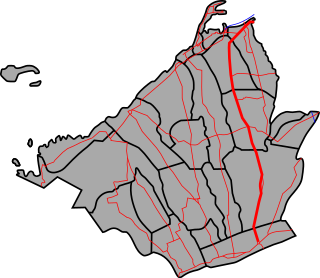
Laguna, officially known as the Province of Laguna, is a province in the Philippines, located in the Calabarzon region in Luzon. Its capital is Santa Cruz and the province is situated southeast of Metro Manila, south of the province of Rizal, west of Quezon, north of Batangas and east of Cavite. Laguna hugs the southern shores of Laguna de Bay, the largest lake in the country. As of the 2015 census, the province's total population is 3,035,081. It is also currently the seventh richest province in the country.

Tagaytay, officially the City of Tagaytay,, or simply known as Tagaytay City, is a 2nd class city in the province of Cavite, Philippines. According to the 2015 census, it has a population of 71,181 people.

San Mateo, officially the Municipality of San Mateo,, is a 1st class municipality in the province of Rizal, Philippines. According to the 2015 census, it has a population of 579,925. It is bordered by Quezon City to the west, the cities of Marikina and Antipolo to the south, and to the north by the municipality of Rodriguez. San Mateo is approximately 24 kilometres (15 mi) east of Manila and 11 kilometres (6.8 mi) north of Pasig, the former provincial capital of Rizal.

Siniloan, officially the Municipality of Siniloan,, is a 2nd class municipality in the province of Laguna, Philippines. According to the 2015 census, it has a population of 38,067 people.

Santa, officially the Municipality of Santa, is a 4th class municipality in the province of Ilocos Sur, Philippines. According to the 2015 census, it has a population of 15,340 people.

Calbayog, officially the City of Calbayog, and often referred to as Calbayog City, is a 1st class city in the province of Samar, Philippines. According to the 2015 census, it has a population of 183,851 people.

Lopez, officially the Municipality of Lopez,, is a 1st class municipality in the province of Quezon, Philippines. According to the 2015 census, it has a population of 95,167 people.

The Manila–Cavite Expressway, also known as Coastal Road or CAVITEx, is a 14-kilometre-long (8.7 mi) limited-access toll expressway linking Manila to the southern province of Cavite in the Philippines. The entire expressway is designated Expressway Route 3 (E3) of the Philippine expressway network and forms part of Radial Road 1 (R-1) of Manila's arterial road network. It is owned by the Public Estates Authority Tollway Corporation (PEATC), a government corporation and subsidiary of the Public Estates Authority, a government agency under the Office of the President, and is operated by Cavitex Infrastructure Corporation, a unit of Philippine-based company Metro Pacific Investments Corporation (MPIC).

Roxas Boulevard is a popular waterfront promenade in Manila in the Philippines. The boulevard, which runs along the shores of Manila Bay, is well known for its sunsets and stretch of coconut trees. The divided roadway has become a trademark of Philippine tourism, famed for its yacht club, hotels, restaurants, commercial buildings and parks. Originally called Cavite Boulevard, it was renamed Dewey Boulevard in honor of the American Admiral George Dewey, whose forces defeated the Spanish navy in the Battle of Manila Bay in 1898. The boulevard was again renamed to Heiwa Boulevard in late 1941 during Japanese Home Rule and Roxas Boulevard in the 1960s to honor President Manuel Roxas, the fifth president of the Republic of Philippines.

The Emilio Aguinaldo Highway, also known as Cavite–Batangas Road and Manila West Road is a four-to-six lane, 41.4-kilometre (25.7 mi), network of primary and secondary highways passing through the busiest towns and cities of Cavite, Philippines. It is the busiest and most congested of the three major highways located in the province, the others are Governor's Drive and Antero Soriano Highway.

The Crisanto Mendoza Delos Reyes Avenue, formerly known as General Trias–Amadeo–Tagaytay Road, is a two-to-four lane, 40.1-kilometre (24.9 mi), tertiary highway traversing through the central towns and cities of the province of Cavite, Philippines. It connects the city of General Trias to the city of Tagaytay and acts as a secondary road to Aguinaldo Highway. It runs parallel to Aguinaldo Highway.

Mount Sungay, also known as Mount Gonzales, is a mountain in the province of Cavite in the Philippines. Located in eastern Tagaytay, the inactive stratovolcano is the highest point of the province of Cavite at 709 metres (2,326 ft). The slopes of the mountain is the source of the San Cristobal River that flows from the mountain to Silang, Cavite down to its mouth at Laguna de Bay in Calamba, Laguna.

Circumferential Road 6, commonly referred to as C-6, is a 34.24-kilometre (21.28 mi), 6 lane, network of roads and bridges that altogether would form the sixth and outermost beltway of Manila in the Philippines.

The Masungi Georeserve is a conservation area in the Philippines situated in the Southern Sierra Madre range in Baras, Rizal, 47 kilometres (28 mi) east of Manila. It centers on the geological formations of Masungi Rock, at an elevation of 640 metres (2,100 ft). In 1993, the Masungit Rock and its vicinity was proposed to be declared as a Strict Nature Reserve and Wildlife Sanctuary by the Department of Environment and Natural Resources. It has been a popular destination for hikes and day trips from Manila since it opened in 2015 and started development towards Geopark status.

The Tanza–Trece Martires Road is a 12.559-kilometre (7.804 mi), two-to-four lane, primary highway in Cavite, Philippines. It connects the municipality of Tanza to the city of Trece Martires.

The Tagaytay–Santa Rosa Road, or Tagaytay–Santa Rosa Highway, is a 23.245-kilometre (14.444 mi), two-to-four lane, secondary highway traversing the provinces of Laguna and Cavite, Philippines. The road was constructed in the late 1990s.

The Trece Martires–Indang Road is a two-to-four lane, 12.015-kilometre (7.466 mi) major highway in Cavite, Philippines. It connects the city of Trece Martires and the municipality of Indang, and the fastest way from Trece Martires to Tagaytay.


























